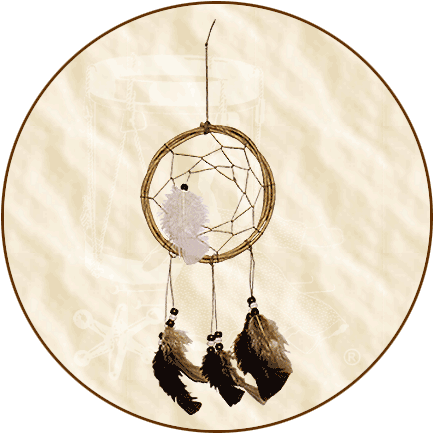.
Continued from product description on
Native American's Page Three...
Historical
Background: Since people began having compelling dreams,
they have at times placed a great deal of significance on their
"night visions." Nearly every culture in man's history
has assigned meanings to dreams and associated them with the
spiritual world. Dreams continue to play an important part in
many individuals' lives.
Over the centuries, dreams have been given many meanings by
Native Americans. Because of this, many Native American legends
have been created based solely on dreams. Among these is the
legend of the dream catcher.
The dream catcher is a "power object" that is hung
over or near a person's bed. In one custom, the dream catcher
must also be placed where the morning light will shine on it.
The spiritual nature of a dream catcher is to attract dreams
to its web. Bad dreams are "caught" and prevented from
traveling into a sleeper's head. On the other hand, good dreams
are able to find their way through the web and into the slumbering
mind of the dreamer. When the morning light hits the dream catcher,
any bad dreams that have been caught during the night vanish.
Many tribes believed that the night air was filled with both
good and bad dreams. The purpose of the dream catcher to them
was to move freely in the air and catch any dreams that happened
to float by. Again, all bad dreams were caught by the web while
all good dreams were capable of traveling on to the owner.
The size of the opening in the web's center was also believed
to determine the number of dreams one desired to receive. To
many, this opening paralleled the changes that might occur in
one's lifetime. Dream catchers were also used to help people
remember their dreams. While some people today will look upon
a dream catcher as a decorative ornament, others will regard
it as a serious tool.
A dream catcher is created from a hoop with a weaving that
looks much like a spider's web. The hoop was usually made from
a slender willow branch, and animal sinew was used to make the
webbing. Different tribes used various materials for their dream
catchers, depending on what was readily available. Oftentimes,
beads were attached at the bottom of the dream catcher. Beads
could be seeds, pieces of carved wood, small seashells, and/or
small stones.
Dream catchers were small in size. The width of the dream
catcher was usually 3 to 5 inches. While one may see larger diameter
dream catchers today, they are "beyond the scope of tradition."
And according to tradition, dream catchers must be made entirely
from natural materials. Not all dream catchers were circular
either! In parts of the northeastern United States and Canada,
it was customary to use teardrop hoops to create dream catchers
that resembled snowshoes.
Many tribal cultures also placed special meanings on the items
used to make a dream catcher. One such item was using a bird's
feather, which represented "breath" or "air."
Feathers were considered important because they "caught"
the bad (unimportant) dreams and allowed good (important) dreams
to slide down the feather and into a person's head.
According to one legend, the Native American dream catcher
comes from the Ojibwe (Chippewa) tribe. Long ago in ancient times,
the clans of the Ojibwe Nation were located in a land called
"Turtle Island" (North America). Here old Ojibwe storytellers
recounted the tales of Asibikaashi (or Spider Woman) and her
dream catcher.
Asibikaashi was a spiritual being that helped the Ojibwe of
all ages bring giizis (the sun) back to them and end the night.
Right before dawn, she would build her lodge so that one could
see if they were awake to see the sunrise reflect on the morning
dew. The sparkling light on the dew was a miracle made by a spiritual
presence to the Ojibwe.
Asibikaashi took care of the Ojibwe in many important respects,
especially babies. When the Ojibwe Nation migrated to other North
American regions, it became difficult for Asibikaashi to get
around and protect her children. To help Asibikaashi get to all
of her children, mothers (as well as sisters and grandmothers)
began making dream catchers.
It was traditional for Ojibwe women to make circular hoops
of willow. The circle represented the path the sun (giizis) traveled
each day across the sky. Another tradition was to hang a feather
from the center of the web. To them, the feather was an essential
item for it represented life and allowed good dreams to flow
through the web to the dreamer. As the Ojibwe continued to travel
to other parts of North America, the lore and practice of using
dream catchers spread to other tribes.
To honor Asibikaashi, the web weaving connected to the hoop
at eight points. These points represented Spider Woman's eight
legs. Sometimes seven points were used to represent the Seven
Prophecies.
As stated earlier, there are many legends that describe the
dream catcher's origin. Here is one such legend:
A spider was quietly spinning his web beside the sleeping
space of Nokomis, the grandmother. Each day, Nokomis watched
the spider quietly spin his web. One day as she watched him,
her grandson came to her and saw the spider. "Nokomis-iya!"
he shouted when he saw the spider. He moved towards it with the
intent to kill the spider. "No-keegwa," the grandmother
whispered, "do not hurt him." The little boy asked,
"Nokomis, why do you protect this spider?"
The old woman smiled, but did not answer her grandson. After
the boy had left, the spider went to Nokomis and thanked her
for saving his life. "You have admired my work. In return
for saving my life, I will give you a gift." Then the spider
smiled and left the grandmother, spinning a web as he went. Soon
the moon glistened on a magical, silvery web that moved gently
in the window.
"See how I spin?" the spider said. "Watch and
learn, for this web will snare bad dreams. Only good dreams will
go through the web's hole. This is my gift to you. Use it so
that only good dreams will be remembered. The bad dreams will
become hopelessly entangled in the web."
If you like reading dream catcher legends, here is another
one:
Long ago when the world was young, an old Lakota spiritual
leader had a vision while on a mountain's summit. In his vision,
Iktomi (the great trickster and teacher of wisdom) appeared in
the form of a spider. Iktomi spoke to the old man in a sacred
language. As Iktomi spoke, the spider picked up the spiritual
leader's hoop of feathers, horsehair, and beads and began to
spin a web.
He spoke to the elder about the cycles of life: how we begin
our lives as infants, pass through childhood, and become adults.
"Finally, we grow to old age where we must again be taken
care of like infants, thus completing the cycle of life,"
said Iktomi. "But," the spider said as he continued
to spin his web, "in each time of life there are many forces.
Some are good and some are bad. If you listen to the good forces,
they will guide you in the right direction of life. But, if you
listen to the bad forces, they will steer you in the wrong direction
and hurt you. These forces can either help you or hinder your
path to harmony with Nature." As the spider spoke, he continued
to weave a web on the spiritual leader's hoop.
When Iktomi had finished speaking, he gave the elder the web
weaving and said, "The web is a perfect circle with a hole
in the center. Use the web to help your people reach their goals,
make good use of their ideas, dreams and visions. If you believe
in the Great Spirit, the web will catch your bad dreams and your
good dreams will travel through the hole."
For those who like reading poetry, here is a dream catcher
poem by an unknown author:
The dream net has been made
For many generations
Where spirit dreams have played.
Hung over the cradle board,
Or in the lodge up high,
The dream net catches bad dreams,
While good dreams slip on by.
Bad dreams become entangled
Among the sinew thread.
Good dreams slip through the center hole,
While you dream upon your bed.
This is an ancient legend,
Since dreams will never cease,
Hang this dream net above your bed,
Dream on, and be at peace.
Today, dream catchers are still used to protect us from bad
dreams and have remained a spiritual tool for many who seek happiness
and wisdom in life. With our Native American Dream Catcher Kit
(6008), you can weave a web that will snare your bad dreams and
allow only good dreams to pass through its hole to you as you
sleep.
Fun
Fact: The feather of an owl was used by the Ojibwe to
gain wisdom from their dream catchers. An eagle feather was used
to gain courage. Women usually preferred using owl feathers while
the men usually used eagle feathers.













